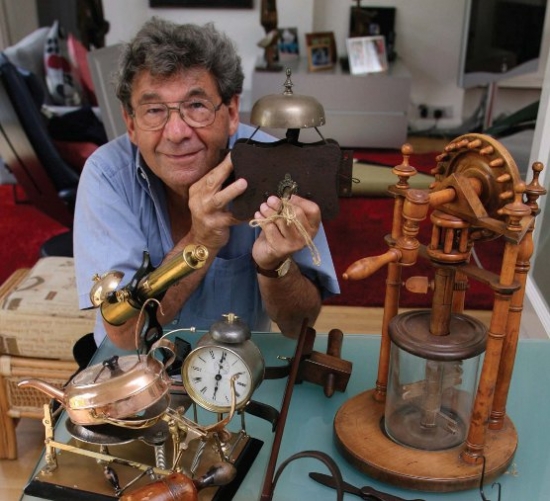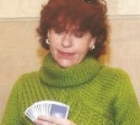
How I become a collector of weird, eccentric and everyday gadgets and contraptions from the past
It all started down a hole in the ground on a Victorian rubbish dump in North London. My son, aged 13 decided that he wanted to dig for old bottles and pot lids on a local dump, which he saw others teenagers were doing on a children’s TV program in the seventies.
So here we were, down this dirty damp trench in bad weather, and what was emerging from the earthy wall was an oblong pointed bottle that obviously was meant not to stand up! How intriguing - a bottle that was impossible to stand on its own two feet, ‘what was the point?’ (no pun intended). Thus began my interest in patents, inventions and weird contraptions!
To enlighten you as to the answer to this engaging puzzle and the reason why this bottle could not stand up was to ensure that the cork was always kept damp. The contents were sparkling mineral water which, by a process invented in the late 18th century by a gentleman called Joseph Priestley, imitated the water that the upper classes would ‘take’ at the various spa towns. The bottle itself was invented by William Hamilton in 1814 and continued to be used for nearly 100 years, even when competition from the more famous mineral water container called the Codds bottle, invented by Hiram Codd, came along in the 1880’s. This was a normal bottle that contained a marble and a washer. When the bottler filled it with the sparkling water or lemonade, the gas forced the marble into the washer and sealed the bottle preventing the gas from escaping. The saying “what a lot of codd’s wallop” derived from this process. Victorian kids had a great time breaking the bottles for the marble!
Just a little research had opened for me an amazing and interesting aspect of how people over the last 100 years had used technology in their everyday life. Those little innovations that had been forgotten or never manufactured, or had evolved into the many gadgets and contraptions we use today without ever thinking how our forebears solved problems 100 years ago. I resolved to try to collect the minutiae of everyday life, those ingenious products that attempted to solve a human difficulty, be it in the kitchen, home, office or a leisure activity.
But I did need to set some parameters for the collection. I had to define how I would select my purchases. Would it be any product that had been produced between 1851 and 1951 (The Great Industrial Exhibition and The Festival of Britain) or did I need some other measures? As far as I can now retrospectively work out, there were some subconscious rules: the item should be solving a problem in an unusual way, would be powered and have a working element of some description, would have an aesthetic quality or was so outrageous that it just had to be a part of the collection.
One of the biggest changes that occur in the development of any product is the way it is energised. The problem is usually the same. Let's take washing clothes by the river. Women pummelled the clothing with their hands or some stone implement to get the dirt removed, then a metal circular object placed on the end of a stick served as the ‘agitator’. Then, in the mid 19th century, the first washing machine was created, of wood. The inside of a box (drum) had a range of ridges which were attached to an outside wheel by way of an axle that had to be turned by hand as rapidly as possible to push the clothes against the ridges to remove the dirt, aided by soap and water. When finished, and believe me it’s hard work, the water is removed and the clothes put through an attached mangle (wringer for the youngsters reading this article). The washing machine of today has all those features - a drum with ridges that agitate, but powered by electricity.
The principle of the development of the method of propulsion is woven into thousands of innovations from the past. Can you imagine a ‘Teasmade’ powered by clockwork. In my collection is the first mechanical, clockwork driven maker of a 'cuppa', as you wake up. Simply, you set the time on the alarm clock and when the bell rings a lever pushes another lever which causes a match to strike, which then lights an oil fire. When the kettle boils, a steel plate cuts across the flames, putting them out, and the water is poured from the kettle into the teapot alongside the machine - perhaps one of the most dangerous fire hazards in the collection! This wonderful innovation was manufactured and marketed in 1902.
Keeping flies off your food in the summer wouldn’t seem much of a problem. You can just cover the food with a cloth, but some Victorian entrepreneur thought that a fly scarer would earn him a fortune, so he used a clockwork device attached to two long paddles, much like a propeller. Then, switching a lever he caused the paddles to turn very slowly over the dinner table thus keeping the dinner unravaged by the flying insects. A most amazing problem solver. Sadly I don’t think that the inventor gave up his day job.
My collection has over 1000 items from tiny patented cuff links which were also used by card sharps to hide the ace, to full sized washing machines and vacuum cleaners. To give you a feel for the collection perhaps I can list some of the variety of inspired inventions from the past:
- Hat measuring machine. This was a most amazing contraption that fitted onto the head and shaped its contours and then translated into the perfectly fitting top hat – c1850
- Clockwork burglar alarm. Crime was rife in the Victorian period and some genius used clockwork to power a small device that went under the door or into the sash of a window. When disturbed, off went the very loud bell. Could it be a product for the 3rd world?
- Bike puncture locator. We are all familiar with the use of a pail and bucket of water, but in the late 20s a small grid-like implement made of metal and full of tiny pin holes provided another system of finding that puncture. It involved the use of chalk powder. When the locator was passed around the tyre the air caused a puff of powder, so the hole was located – seems a great idea, but did it take off?
- Cherry stoner. Stoners of all types of fruits abounded in the 19th century, but the small semi-automated cherry stoner in the collection has always seemed to me exceptional in this simply designed 'two cherries to be stoned at a time' device. It not only removes the stone by piercing the cherry but in the same hand movement it also deposits the fruit into the bowl.
- Envelope sealer. Back in 1914 when selling by post began to take off, inventors began to make machines that were driven by hand which caused the envelopes to be folded and sealed at a rate of 1000 an hour. A vast improvement on the hand work that prevailed in the office of the period.
- Fire grenade. The advertising material for this ‘grenade’ in the Illustrated London News of 1892 showed a mother with her child in a fire and a moustached Victorian gentleman throwing the chemically filled bottle at the flames, which of course put out the conflagration and saved the mother and child.
- Five line chalk drawer. What a simple but labor-saving idea was supplied to the teaching profession in the late 19th century - a wire implement into which the teacher could insert five fingers of chalk and with one stroke draw the lines on the blackboard to teach music.
- Self-pouring teapot. An absolutely brilliant idea developed by a Mr Royal in 1888. You filled the pot with your tea and by depressing the lid, it automatically dispensed one cup of tea with each depression. Made in many designs, it sold tens of thousands over a 30 year period.
My collection, which now numbers over 1000 artifacts, is rented out to museums across Europe, the rental being donated to charities that support people with severe learning disabilities (I have a daughter who is severely learning disabled) with a growing interest by heritage organizations in the need to have on record the ‘labor saving devices from the past’.
Has much changed in the last 150 years of human development? Well, the needs of human beings have remained the same, only technology has developed to deal with those requirements. The lemonade bottle still keeps the same form but the closure has improved, so there is no more need for the pointed bottom or the marble in the neck, burglar alarms have become standard in most homes but now the bell is rung by electricity, the clockwork 'teasmade' evolved into a range of different designs and attachments. The fashion died out in the 1950’s, but is now back in popularity and is being manufactured, the 'Sat-Nav' is now standard in our cars, but back in the 1920’s we had the watch route finder which took us on our journeys without the voices of the present day 'stars'.
The consumer society, with its new innovations and inventions drives the world economy. From the manufacture and distribution of these products we are taxed. That taxation is spent on the needs of the community for the benefit of all – so innovators and inventors keep answering the needs of people and, of course, give an opportunity for collectors of the future to have a great time preserving them!
ESRA MAGAZINE congratulates Maurice Collins for his award on July 11, 2011 from BID TV AS "BRITAIN'S BEST COLLECTOR" for his 1600 items ranging from a clockwork burglar alarm to an electric hair restoring comb.
Maurice Collins will be guest speaker at ESRA in Tel Aviv on Sunday, December 11, and at ESRA in Ashkelon on Monday, December 12, 2011.
Maurice Collins, OBE, MA, was born in London, went to live in Israel in 1956 for a few years and worked as a compositor at The Jerusalem Post. He returned to the United Kingdom and ran his own printing business and other companies. Since 1976 he has been a collector of ephemera, home front posters from World War II as well as the unique 'Weird Gadget Collection'.
 Israel: Reclaiming the Narrative - A Review
Israel: Reclaiming the Narrative - A Review ESRA Outing to Aida at Masada
ESRA Outing to Aida at Masada  Coffee Group for Immigrants enters 5th year
Coffee Group for Immigrants enters 5th year Bridge the right way
Bridge the right way A Bit of Humor on Food
A Bit of Humor on Food ESRA Photo enthusiasts meet monthly
ESRA Photo enthusiasts meet monthly